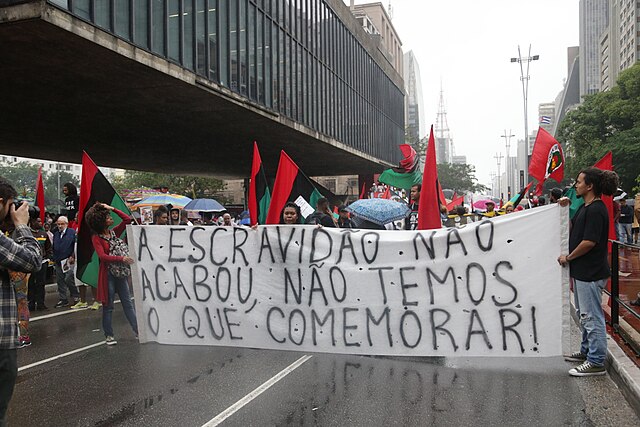Luís Gonzaga Pinto da Gama was a Brazilian rábula, abolitionist, orator, journalist and writer, and the Patron of the abolition of slavery in Brazil.
Cover of the first edition of Primeiras Trovas Burlescas, published in 1859.
Drawing by Raul Pompeia, portraying Gama in O Mequetrefe [pt].
Bust of Gama, inaugurated in 1931, at Largo do Arouche
The history of abolitionism in Brazil goes back to the first attempt to abolish indigenous slavery in Brazil, in 1611, to its definitive abolition by the Marquis of Pombal, in 1755 and 1758, during the reign of King Joseph I, and to the emancipation movements in the colonial period, particularly the 1798 Bahian Conspiracy, whose plans included the eradication of slavery. After the Independence of Brazil (1822), the discussions on this subject extended throughout the Empire period, acquiring relevance from 1850 onwards and a truly popular character from 1870 onwards, culminating with the signing of the Golden Law on May 13, 1888, which abolished slavery in Brazil.
1888 poster from the Brazilian National Archives collection commemorating the abolition of slavery in Brazil
1880 issue of "Revista Illustrada" talking about the abolitionist campaign.
An outdoor Thanksgiving mass, in Rio de Janeiro, brings together Princess Isabel and about twenty thousand people, and celebrates the abolition, on May 17, 1888.
The 14th São Paulo Black Consciousness March in 2017. The poster reads: "Slavery didn't end, we have nothing to celebrate".


![Drawing by Raul Pompeia, portraying Gama in O Mequetrefe [pt].](https://upload.wikimedia.org/wikipedia/commons/thumb/7/7f/Luiz_Gama_by_Raul_Pompeia_1882.jpg/514px-Luiz_Gama_by_Raul_Pompeia_1882.jpg)




